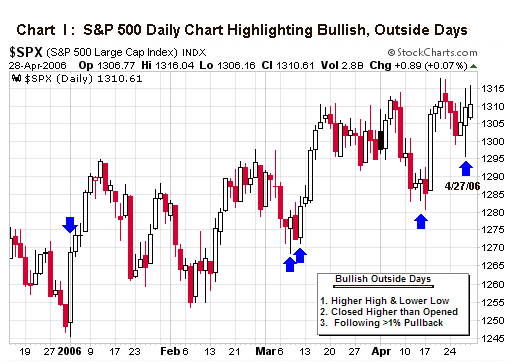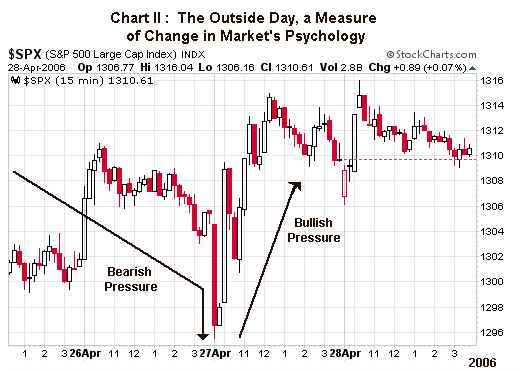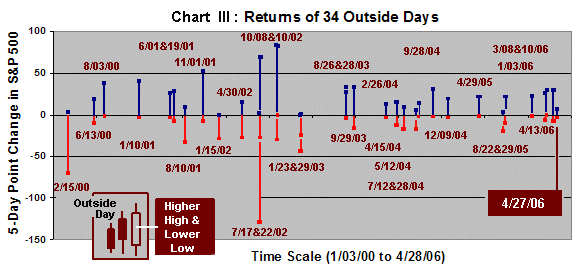TripleScreenMethod.com
Bullish Outside Days: Measure of Change in Market Psychology
Richard W. Miller, Ph.D. Published in May 2006 Issue of CANSLIM.net
Over the past few years, I’ve written here several times about chart patterns that reflect market psychology: pullbacks & 21 day high and lows (Oct/Nov ’04), the “hammer” candlestick (Mar ’05), pullbacks again (Sep/Oct ’05). As traders we’re interested because our vision is short term and market psychology is all-important. As investors we should be interested because these patterns affect our entry points. Today, I want to talk about another pattern because it occurred last Thursday (4/27/06).For must of us living on the Gulf Coast, an outside day (OD) is one spent in the yard—all too frequently clearing up hurricane debris. In the market it’s a day that makes both a higher high and a lower low than one or more prior days. Over the last 1,589 trading days—encompassing the period between 01/03/00 and 4/28/06—the S&P made 162 ODs: 121 where its high/low limits covered just the prior day, 21 the prior two days, 12 the prior three days, and 8 the prior four or more days (email me for an Excel list if you’re interested). Adding two further requirements (the OD’s close must be greater than its open and the OD must be preceded by a pullback of at least 1 percent) reduces this group to 34 occurrences of bullish ODs. Chart I highlights several occurring in the S&P over the past few months.
The market psychology of a bullish, OD is easily understood. Consider the wide-range candle made in January this year. The S&P had been pulling back for a few weeks. The day under the arrow opened up slightly, then bearish pressure drove the index below the prior day low (as well as the prior day lows of all 13 trading days shown). All of a sudden the bulls stepped in and drove the index higher the rest of the day. It made a higher high than the prior three days and went on to trigger a nice move for the index over the next week and a half. Chart II, showing 15-minute candlesticks, highlights the change in psychology over the past three days.
I’ll finish with a few statistics developed from the occurrences over the past six years. If one defines the max 5-day return as the difference between the open on the day following the OD and the high then reached over the 5 days following the OD, 34 bullish ODs produced a median gain of +21.55 points. If one defines the min 5-day return as the difference between the open on the day following the OD and the low then reached over the 5 days following the OD, these same 34 ODs produced a median low of -8.45 points. To add some context, the unrestricted, median 5-day gain for all 1,589 days was +14.55 points; the unrestricted, median 5-day low was –14.98 points. Chart III gives the dates and shows the magnitude of change for the 34 bullish, OD days.
You say, “that’s all interesting, but what does it mean for next week?” Needless to say, recent history would forecast the S&P to make further higher highs over the next week: opened at 1309.72 on 4/28/06 and made a high of 1316.04 for a gain of +6.32 points so far after 4/27/06’s OD (and a high of 1317.21 on 5/02/06 for a gain of +7.49). In any event, watch for future bullish, ODs. They don’t occur often, but they do mark temporary changes in market psychology, and these changes can be used to improve your entry points.


